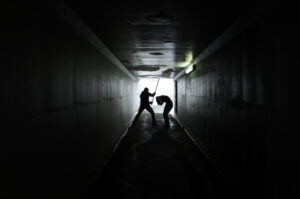Can Tho, 170 km (105 mi) southwest of Ho Chi Minh City, is both a province and the biggest city and hub of the Mekong delta. The region is Vietnam’s breadbasket, but the country has always found it difficult to make the most of its prime agricultural resource.
Transport has never been straightforward in the huge network of waterways that lie between each of the Mekong’s principal tributaries. The River Hau separates Can Tho from Vinh Long province, and the Can Tho road bridge across the Hau was to be the clearest demonstration of Vietnam’s commitment to providing the infrastructure proper to a modern, rural economy. Its 16 km (10 mi) of ramped approach roads would lead to a 2.75 km (1.7 mi) central span – a beautiful cable suspension bridge arcing across the flat, green waterscape. Construction began in 2004 and three years in the project was going well.
It might have been the heavy rain that softened the ground, or just one shortcut too many, or the still-drying concrete poured just the day before. Whichever it was, the scaffolding along the 87 m (270 ft) length of the double span buckled in slow motion and crashed more than 30 m (100 ft) to the ground taking the massive, four-lane, concrete deck with it. The wreckage stood higher than a five-storey building. None of the 250 workers stood a chance as 2,000 tons of concrete and twisted steel just collapsed. Fewer than a dozen workmen and engineers survived totally unscathed.
The bitter irony is that the disaster was not caused by corporate greed. If anything, it was caused by goodwill – the genuine desire of the Japanese building consortium and the Vietnamese government to help the delta farmers get their produce to market quickly.
When: September 26 2007
Where: Hau River bank. Can Tho, Vietnam
Death toll: 65 dead and 180 injured (most of them severely) out of 250 on site.
You should know: The bridge’s opening was delayed from 2008 to 2010, upsetting collateral regional improvement including Tra Noc airport, which re-opened in 2009 as ‘Can Tho International’ but could only offer onward transit by ferry. The Japanese consortium showed immense dignity by apologizing even before the independent enquiry was announced. Safety procedures were immediately reviewed and work was started again as quickly as possible.






















